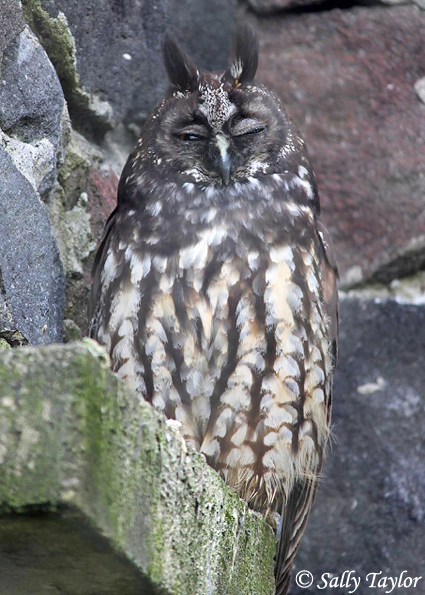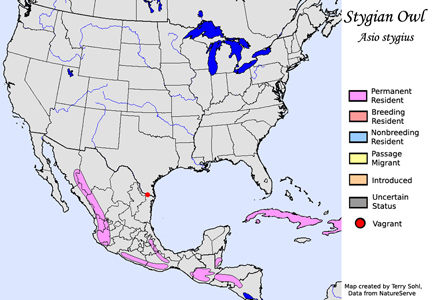| Length: 15-18 inches | Wingspan: 40-46 inches | Seasonality: Non-resident in South Dakota |
| ID Keys: Dark overall, obvious ear tufts, dark beak, dark upperparts, lighter underparts with dark vertical barring | ||
 The
Stygian Owl is a bird of Mexico, Central America, and the Caribbean.
While its range is well south of the United States and it is typically
non-migratory, the species has twice been found in south Texas. The
term Stygian refers to the river Styx, a term that in this case likely
refers to the species' overall dark coloration rather than any association
with "hell". The ear tufts that are obviously visible in the photo to
the right are often only visible when the owl is alert or agitated, as
relaxed Stygian Owls often show little indication of ear tufts.
The
Stygian Owl is a bird of Mexico, Central America, and the Caribbean.
While its range is well south of the United States and it is typically
non-migratory, the species has twice been found in south Texas. The
term Stygian refers to the river Styx, a term that in this case likely
refers to the species' overall dark coloration rather than any association
with "hell". The ear tufts that are obviously visible in the photo to
the right are often only visible when the owl is alert or agitated, as
relaxed Stygian Owls often show little indication of ear tufts.
Habitat: In Mexico, they are often found in open pine and pine-oak woodlands and forests. They often occur in montane forests, and are found much less often at lower elevations.
Diet: Stygian Owls will feed on a wide variety of prey items, including small rodents, bats, birds, reptiles, and large insects.
Behavior: The species is nocturnal. During the day, it prefers to roost undisturbed in dense vegetation. At night, foraging is often done in more open habitats, however.
Nesting: Stygian Owls have been noted for nesting in stick nests built by other species, but they have also been found to nest on the ground, and nest in junctions of large tree branches. The female evidently incubates the eggs by herself, but both the male and female will help to raise the young.
Song: Males have a strong, desending Huuuuu. Agitated birds of both sexes have a wok-wok-wok call.
Migration: Stygian Owls are considered permanent residents throughout their normial range.
Interactive eBird map: Click here to access an interactive map of Stygian Owl sightings
Similar Species: Similar to Long-eared Owl in overall structure, but Stygian Owls are darker and also larger in size.
Conservation Status: There are currently no perceived major threats to Stygian Owl populations. The IUCN currently lists it as a species of "Least Concern".
Further Information: 1) Cornell's Neotropical Birds - Stygian Owl
2) AvianWeb - Stygian Owl
3) The Owl Pages - Stygian Owl
Photo Information: May 27th, 2011 - Ecuador - Sally Taylor
Additional Photos: Additional Photos Coming Soon!!
| Click below for a higher-resolution map |
 |
| South Dakota Status: Non-resident in South Dakota |
Additional Stygian Owl Photos (coming soon!!)
